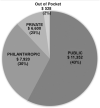Establishing a High-Quality Congenital Cardiac Surgery Program in a Developing Country: Lessons Learned
- PMID: 32850519
- PMCID: PMC7406661
- DOI: 10.3389/fped.2020.00357
Establishing a High-Quality Congenital Cardiac Surgery Program in a Developing Country: Lessons Learned
Abstract
Background: Developing countries are profoundly affected by the burden of congenital heart disease (CHD) because of limited resources, poverty, cost, and inefficient governance. The outcome of pediatric cardiac surgery in developing countries is suboptimal, and the availability of sustainable programs is minimal. Aim: This study describes the establishment of a high quality in-situ pediatric cardiac surgery program in Lebanon, a limited resource country. Methods: We enrolled all patients operated for CHD at the Children's Heart Center at the American University of Beirut between January 2014 and December 2018. Financial information was obtained. We established a partnership between the state, private University hospital, and philanthropic organizations to support the program. Results: In 5 years, 856 consecutive patients underwent 993 surgical procedures. Neonates and infants constituted 22.5 and 22.6% of our cohort, respectively. Most patients (82.6%) underwent one cardiac procedure. Our results were similar to those of the Society of Thoracic Surgeons (STS) harvest and to the expected mortalities in RACHS-1 scores with an overall mortality of 2.8%. The government (Public) covered 43% of the hospital bill, the Philanthropic organizations covered 30%, and the Private hospital provided a 25% discount. The parents' out-of-pocket contribution included another 2%. The average cost per patient, including neonates, was $19,800. Conclusion: High standard pediatric cardiac surgery programs can be achieved in limited-resource countries, with outcome measures comparable to developed countries. We established a viable financial model through a tripartite partnership between Public, Private, and Philanthropy (3P system) to provide high caliber care to children with CHD.
Keywords: cardiac surgery; children; congenital heart disease; developing countries; pediatric cardiac program.
Copyright © 2020 El Rassi, Assy, Arabi, Majdalani, Yunis, Sharara, Maroun-Aouad, Khaddoum, Siddik-Sayyid, Foz, Bulbul and Bitar.
Figures
References
-
- Lee KB. Pediatric Cardiac Surgery in Developing Countries of Africa: Current State and Future Directions. Thesis. Georgetown, TX: The University of Texas at Southwestern Medical Center; (2012).
LinkOut - more resources
Full Text Sources


